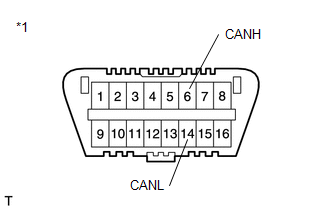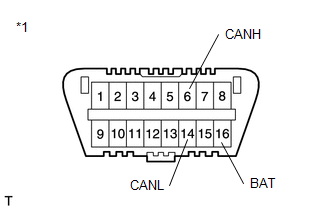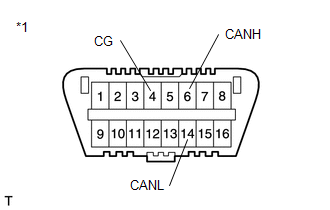| Last Modified: 08-28-2024 | 6.11:8.1.0 | Doc ID: RM100000000WPGZ |
| Model Year Start: 2016 | Model: Sienna | Prod Date Range: [12/2015 - 08/2016] |
| Title: NETWORKING: CAN COMMUNICATION SYSTEM: HOW TO PROCEED WITH TROUBLESHOOTING; 2016 MY Sienna [12/2015 - 08/2016] | ||
|
HOW TO PROCEED WITH TROUBLESHOOTING |
CAUTION / NOTICE / HINT
Disconnect the cable from the negative (-) battery terminal before measuring the resistances of the main wire and the branch wire.
CAUTION:
Wait at least 90 seconds after disconnecting the cable from the negative (-) battery terminal to disable the SRS system.
NOTICE:
- DTCs for the CAN communication system are as follows: U0100, U0101, U0104, U0122, U0123, U0124, U0126, U0128, U0129, U0131, U0140, U0142, U0151, U0155, U0182, U0199, U0200, U0201, U0202, U0208, U0233, U0327, U1002, U1104, U1100, U1104, U1110, U1133, U110B, B1499, B2799, C1203 and C1437.
- Refer to the troubleshooting procedures of each system if DTCs regarding the CAN communication system are not output.
- Before measuring the resistance, leave the vehicle for at least 1 minute and do not operate the ignition switch, any switches or doors. If doors need to be opened in order to check connectors, open the doors and leave them open.
HINT:
- Operating the ignition switch, any switches or any doors triggers related ECU and sensor communication with the CAN, which causes resistance variation.
- *: Use the Techstream.
PROCEDURE
|
1. |
VEHICLE BROUGHT TO WORKSHOP |
|
|
2. |
INSPECT BATTERY VOLTAGE |
Standard voltage:
11 to 14 V
If the voltage is below 11 V, recharge or replace the battery before proceeding.
|
|
3. |
CHECK AND CLEAR DTC* |
(a) Using the Techstream, perform the Health Check (all DTCs check).
NOTICE:
- If there is a CAN communication trouble code that indicates that an ECU or sensor has a power malfunction or interior malfunction which is causing a communication stop, the problem may not be in the communication line.
- When CAN communication related connectors are disconnected with the ignition switch ON or ACC, the ECU related to the connector and ECUs of related systems will store a CAN communication DTC.
|
|
4. |
CHECK INSTALLED SYSTEMS (ECU AND SENSOR) THAT USE CAN COMMUNICATION |
(a) Based on the vehicle equipment and specifications, confirm the systems that use CAN communication.
|
|
5. |
CHECK DLC3 BRANCH WIRE AND V BUS CIRCUIT MAIN WIRE (CANH - CANL) |
(a) Disconnect the cable from the negative (-) battery terminal before measuring the resistances of the main wire and the branch wire.
|
(b) Measure the resistance according to the value(s) in the table below. Standard Resistance:
|
|
| B |

|
| C |

|
|
|
6. |
CHECK V BUS CIRCUIT +B (CANH, CANL - BAT) |
|
(a) Measure the resistance according to the value(s) in the table below. Standard Resistance:
|
|
| NG |

|
|
|
7. |
CHECK V BUS CIRCUIT GND (CANH, CANL - CG) |
|
(a) Measure the resistance according to the value(s) in the table below. Standard Resistance:
|
|
| NG |

|
|
|
8. |
CHECK ECUS CONNECTED TO CAN BUS* |
*1: w/ Smart Key System
*2: w/o Smart Key System
(a) Connect the cable to the negative (-) battery terminal.
(b) Select "CAN Bus Check" from "System Select".
(c) Wait 1 minute and then check the display of the connected ECUs and sensors.
|
Inspection Result |
Proceed to |
|---|---|
|
All ECUs and sensors connected to the CAN communication system are displayed on the screen. |
A |
|
Except for the power management control ECU*1 or network gateway ECU*2, no ECUs connected to the V2 bus are displayed. The power management control ECU*1 or network gateway ECU*2 outputs the V2 bus trouble code (U1002) (the V2 bus main wire open or short malfunction). |
B |
|
Except for the power management control ECU*1, no ECUs connected to the power management bus are displayed. The power management control ECU*1 outputs the power management bus trouble code (U1002) (the power management bus main wire open or short malfunction). |
C |
|
Except for the main body ECU (multiplex network body ECU), no ECUs connected to the MS bus are displayed. The main body ECU (multiplex network body ECU) outputs the MS bus trouble code (U1002) (the MS bus main wire open or short malfunction). |
D |
|
An ECU or sensor that should be connected to the CAN communication system is not displayed (the ECU or sensor branch wire is open). |
E |
|
An ECU or sensor that should be connected to the CAN communication system is not displayed or display is intermittent during check (the ECU or sensor branch wire is open on one side). |
F |
NOTICE:
The ECUs and sensors that are not present will not be displayed. Be careful not to mistake them for communication stop malfunctions.
HINT:
- If the display of an ECU is intermittent during the check, one side of an ECU or sensor branch wire is open (The signal of the ECU is treated as noise, which affects the response and display of the Techstream).
- The power management control ECU*1 or network gateway ECU*2 checks for proper ECU communication for ECUs that are connected to the CAN V2 bus circuit, and the results are displayed on the Techstream.
- The gateway ECU built into the power management control ECU*1 or network gateway ECU*2 may be malfunctioning if both of the following occur: 1) all ECUs connected to the V2 bus are not displayed on the Techstream; and 2) DTC U1002 is not output.
- The power management control ECU checks for proper ECU communication for ECUs that are connected to the power management bus circuit, and the results are displayed on the Techstream.
- The gateway ECU built into the power management control ECU may be malfunctioning if both of the following occur: 1) all ECUs connected to the power management bus are not displayed on the Techstream; and 2) DTC U1002 is not output.
- The main body ECU checks for proper ECU communication for ECUs that are connected to the CAN MS bus circuit, and the results are displayed on the Techstream.
- The gateway ECU built into the main body ECU (multiplex network body ECU) may be malfunctioning if both of the following occur: 1) all ECUs connected to the MS bus are not displayed on the Techstream; and 2) DTC U1002 is not output.
- If communication stops between an ECU and the main body ECU (multiplex network body ECU) or network gateway ECU for 10 seconds or more, the ECU disappears from the Techstream display.
- For communication stop mode of ECUs connected to the CAN V2 bus circuit, power management bus circuit or CAN MS bus circuit, refer to the DTC flowchart of the respective communication stop.
| B |

|
| C |

|
| D |

|
| E |

|
| F |

|
|
|
9. |
CHECK COMMUNICATION MALFUNCTION DTC (PAST DTC CHECK)* |
*1: w/ Smart Key System
*2: w/o Smart Key System
(a) Select "CAN Bus Check" from "System Select".
(b) Write down all of the DTCs stored in each ECU.
HINT:
- If there are communication malfunction DTCs stored but the Techstream "CAN Bus Check - Communication Bus Check" screen displays all of the ECUs and sensors connected to the CAN system, the communication malfunction DTCs may be past malfunctions that are no longer present.
- For V1 bus main wire malfunctions, related ECUs are also detected. Therefore, determine the malfunctioning area based on all of the DTCs that are output.
- For V2 bus malfunctions, DTCs are stored based on the detection of communication stop malfunctions and network malfunctions of ECUs that are connected by the power management control ECU*1 or network gateway ECU*2.
- For power management bus malfunctions, DTCs are stored based on the detection of communication stop malfunctions and network malfunctions of ECUs that are connected by the power management control ECU*1.
- For MS bus malfunctions, DTCs are stored based on the detection of communication stop malfunctions and network malfunctions of ECUs that are connected by the main body ECU (multiplex network body ECU).
|
Inspection Result |
Proceed to |
|---|---|
|
An ECU connected to the V bus main wire has stored a communication trouble code (V bus main wire past malfunction). |
A |
|
The power management control ECU*1 or network gateway ECU*2 (power management1) outputs the V2 bus trouble code (U1002) (V2 bus past malfunction). |
B |
|
The power management control ECU*1 (power management2) outputs the power management bus trouble code (U1002) (power management bus past malfunction). |
C |
|
The main body ECU (multiplex network body ECU) outputs the MS bus trouble code (U1002) (MS bus past malfunction). |
D |
|
The power management control ECU*1 or network gateway ECU*2 (power management1) outputs a trouble code other than V2 bus trouble code (U1002) (past malfunction of branch wire connected to V2 bus). |
E |
|
The power management control ECU*1 (power management2) outputs a trouble code other than power management bus trouble code (U1002) (past malfunction of branch wire connected to power management bus). |
E |
|
The main body ECU (multiplex network body ECU) outputs a trouble code other than MS bus trouble code (U1002) (past malfunction of ECU branch wire connected to MS bus). |
E |
| B |

|
| C |

|
| D |

|
| E |

|
|
|
10. |
CHECK DTC COMBINATION TABLE (V BUS CIRCUIT BRANCH WIRE OPEN PAST MALFUNCTION) |
(a) Based on the combination of stored CAN communication system DTCs, determine which ECUs and sensors have a communication stop malfunction.
|
|
11. |
PERFORM MALFUNCTION SIMULATION TEST (V BUS CIRCUIT MAIN WIRE PAST MALFUNCTION)* |
(a) Using the Techstream, clear all DTCs.
(b) Perform a malfunction simulation test on all harnesses and connectors related to the V bus circuit main wire.
(c) Check the DTCs that were stored as a result of the malfunction simulation test. Then determine the malfunctioning area.
|
|
12. |
ADJUST, REPAIR AND REPLACE |
|
|
13. |
CONFIRMATION TEST |
| NEXT |

|
END |
|
|
|

![2016 MY Sienna [12/2015 - 08/2016]; NETWORKING: CAN COMMUNICATION SYSTEM: DIAGNOSIS SYSTEM](/t3Portal/stylegraphics/info.gif)


